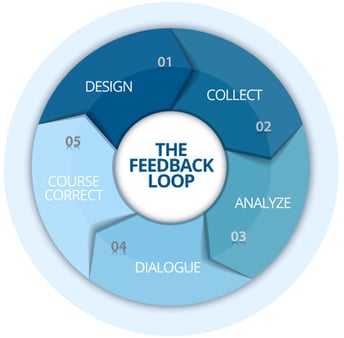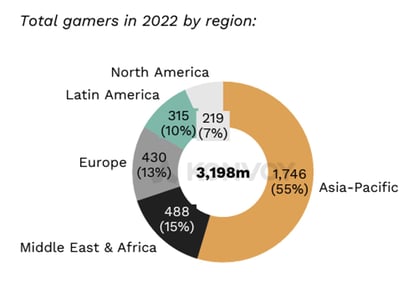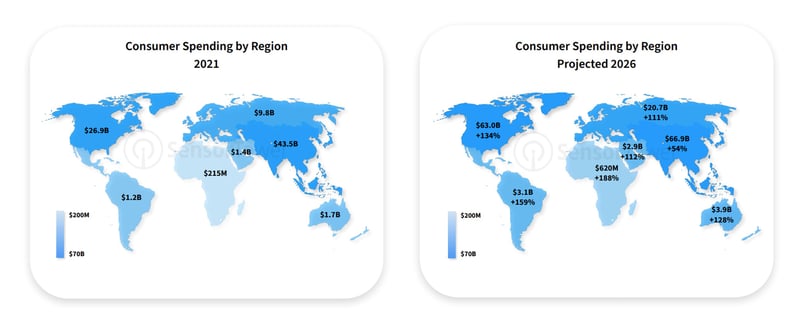Looking ahead, it's clear that the app world will face its fair share of disruption. To make it safely to the other side, publishers will need to be able to thoroughly understand what's happening, accurately anticipate what will happen, and effectively bridge the two with agile and opportunistic app strategy.
But here's the thing: disruption is not a single contained event. It might seem that way, but it's not. It's not something that happens. It's many things that have happened and are happening still. There is a continuity to it. Despite the popular conception, it is more of a stream than a wave.
It follows that businesses will not be able to make the most of the disruption they face with a single one-off proclamation, project, or pivot. It needs to be approached with continuity. Not as a one-time event, but as a relentless succession of inter-related events.
This article, the second in a two-part series, was written with that idea in mind. In the first part, we looked at the year-end data and industry forecasts to identify 3 trends sure to shape the market going forward. Here, we'll connect trend to takeaway and illumination to implementation.
Pulling the Common App Strategy Thread
In the forerunning article we highlighted three facts that we expect to lay the foundation for things to come:
- Acquiring new users will be much more difficult going forward
- Consolidation is the name of the game across the industry
- Monetization strategies are being redesigned in pursuit of revenue diversification
The takeaways in this article will cut across and build on those trends — seizing on their common themes. As such, all three takeaways are inter-related. Indeed, each may seem a natural extension of the others. They are all essentially tied to the question of future-proofing in the face of disruption, after all. But this speaks to the continuity mentioned above.
By the end of this article, you should have a better handle on the specific events and app strategies that will pave your path to success in this constantly evolving market.
Takeaway No 1: Invest in independence and interoperability
Many of the driving forces behind industry disruption are changes specific to a given platform or ecosystem. For example, when Mopub sold to AppLovin it created serious disruption for publishers who had built their operations around the former's mediation services. The same is true for publishers with disproportionate strategic investments in iOS. When Apple added opt-in requirements to IDFA, it totally changed how such publishers operated. And the merger of Unity and ironSource may also send an operational shockwave through the market.
Of course those are dramatic examples. But there are many more examples of smaller platform/ecosystem disruptions that throw a wrench into the spokes of app growth and monetization on a daily basis.
The prospect of lock-in presents a real risk to any business, but its particularly true of app businesses. And that's true whether its lock-in from a vendor, network, mediation, OS, monetization model, etc. Regardless of the details, over-reliance on any one single partner or platform puts you in a position of weakness. The best way to protect yourself from that is to deliberately build your stack in as independent and interoperable a manner as possible.
Usually that will mean more work to start but more sustainability and less upheaval down the line. Inconvenient as it may be, it's worth the effort today to avoid having to spend too much time and effort later reinventing daily practices in the face of disruption.
There's a lot to be said for prioritizing partners whose only stake in the market comes from the product or service on offer. Partners who are vertically and horizontally integrated into the market (like the BigTech brands) have vested interests that are likely to work against you sooner or later.
It should go without saying that you need to know your business to succeed. Less obvious but just as true is the importance of knowing the business of your partners. You should be fastidious about doing your homework and you should be hellbent on transparency.
When there's bias, transparency is usually the first casualty. Because of that, transparency can also be used as a sort of litmus test. If a vendor cannot provide you with thorough transparency, they likely have skin in the game.
Publishers understand this, but often fail to act in accordance with that understanding. When surveyed, 65% of app leaders state that finding unbiased third-party partners is essential to their success. The problem is that so few of the big names and market-standard options are unbiased — so those with vested interests typically dominate the paths of least resistance.
But it's not binary, and smart developers will find a way to keep all the standard channels open while still investing in new partnerships with unbiased third-parties. Going forward, we expect success to correlate with a publisher's willingness to put in that extra effort. And once that association takes root, standards will begin to change too.
 And the success at issue isn't just about resilience. It's also about performance. At oolo, for example, we've found that when publishers make room in their stacks and processes for third-party measurement, attribution, and analytics, it results in higher engagement and greater retention — ultimately translating to ARPU uplift of almost 30%, on average.
And the success at issue isn't just about resilience. It's also about performance. At oolo, for example, we've found that when publishers make room in their stacks and processes for third-party measurement, attribution, and analytics, it results in higher engagement and greater retention — ultimately translating to ARPU uplift of almost 30%, on average.
Similarly, by working with multiple ad networks and demand partners, it gives publishers more variables to test in pursuit of greater efficiency and effectiveness. To coax more value from their apps, publishers can make waterfall and setup adjustments to optimize for the strengths and weaknesses of different networks and demand partners.
But even without that level of involvement and attentiveness, a diversified approach still makes sense and works to your benefit — for example by driving increased competition on ad inventory — raising prices, and increasing revenue.
Laying out an app strategy and smart processes with the goal of independence and interoperability is good business at the firm level. In the aggregate — at the market level — it'll also serve as a powerful curb against the full force of the consolidation crunch and BigTech bullying.
Takeaway No 2: Design processes for operational agility
With so much movement in the market, you're liable to suffer a spell of dizziness from time to time; especially if you've built your operation on top of a sprawling, diversified, vendor neutral, and technologically ambidextrous ad stack — as advised in takeaway no 1.
Keeping on top of industry changes can be tall task. Keeping on top of subtly expressed but potentially significant data changes is downright Sisyphean.
When considering all the different apps, platforms, analytical dimensions, and key metrics, we're literally talking about millions of data points every day. It doesn't stop there though. As the data proliferates, so does its complexity, and commensurately the need to examine it with deep context-awareness.
Despite the mounting complexity, benchmark detection and response times are only growing more aggressive. Which shouldn't come as a complete surprise since the more disrupted and volatile a market is, the more important it is that businesses are able to process, make sense of data, and operationally adapt in near-real-time.

Especially with times now toughening, every little bit is sure to either help or hurt. And every detail will need to be seen, studied, and sent into motion in the form of a fix or optimization.
Data mastery will also help the business iterate and improve more effectively — giving you a leg up on the competition in the process.
There may be more than one way to skin a cat, but who the hell wants to do that! When it comes to designing smart processes that run on and promote operational agility, it all comes down to tightening and deepening the data feedback loop.
It's about maximizing efficiency through centralized data monitoring and augmented intelligence. To get there, you'll need the right tools. If you want to bend trends to your advantage, you need to be sure that whenever something meaningful occurs or changes development, you'll be in the know and ready to go.
Until recently, dashboards visualizing thousands of data points have been the go-to. But dashboards are an intensive affair. To get the most out of them, publishers need to review myriads of data points everyday and constantly tweak their tracking parameters to reliably spot signs of impeded performance. But that type of approach to data is slow and imperfect — hamstringing any attempt at operational agility.
If the goal is to rapidly seek and solve problems affecting your business, dashboards can help, but only to a point. Visibility will only ever extend to the pre-defined metrics and dimensions. And even then, it requires hours manually reviewing and investigating numbers that look or feel iffy. Thankfully, there's a new generation of technologies coming to market to change that. oolo, for example, uses machine learning to perfect and automate the processes.
oolo's dragnet covers both UA and Monetization — serving all manner of alerts from Performance to Setup, Discrepancies to A/B Tests, Cohorts to Channels etc. — tracking all key metrics and across all relevant dimensions. If, for example, interstitial CPMs unexpectedly drop for any combination of device, geo, and app, oolo will let you know about it and tell you that the event is associated with increased timeouts following VAST setup changes.
Together with lightening-fast technologies, smart and streamlined workflows will be key to achieving (and maintaining) operational agility. Only with those building blocks in place can you expect to muster the required level of data-responsiveness and dynamism.

Takeaway No 3: Live for today but lay the groundwork for tomorrow
Being ahead of the curve is generally considered a good thing. Except for when it's not. If you're too far ahead of the curve and you lack any firm footing in the present, you may find yourself in a position familiar to Microsoft's Tablet PC or Apple's Newton PDA. Real success isn't about living in the future it's about running with the present while building for the future. And this should be the guiding mindset that regulates your approach to interoperability and agility.
Think about in-app bidding for an in-industry example. Publishers who were over-eager to jump into the future didn't end up doing themselves any favors. Instead, they created unnecessary internal upheaval, abandoned valuable demand partners, and endured wavering performance as the networks continued to work out the kinks.
It's a poignant example, but please don't misunderstand: we're not against in-app bidding and we're not against embracing change. To the contrary, we're fully convinced that bidding is the wave of the future and we're equally convinced that future-forward planning is key to long-term success. But the principle "get while the getting is good" must be front and center.
Still, with all the disruption on the horizon, 2023 will be as a good a year as any for publishers to embrace future-planning. It's a sentiment shared by many in the industry, including Reggie Singh of Adjust, who predicted that "we’re going to see companies focus much more on forecasting and strategic budget planning than ever before."
When considering how publishers might seize on the market developments highlighted in our top trends article, certain initiatives stand out. Revisiting regional strategy and investments is one good example. As fierce competition and over-saturation erodes value in more mature markets, the smart app strategy will stake out strategic positioning in emerging markets.
That will mean not only targeting growth activities to specific geos, but translating the portfolio and creating specific titles tailored to regional tastes and around cultural touchstones.
Such a strategic shift isn't only sound in theory, but supported by the trending fundamentals too. Over the next several years, for example, consumer spending and downloads are expected to grow much faster in Africa and South America than in the US and Europe.
And over that same period of time, Brazil is likely to overtake the US in terms of downloads to become the third largest market in the world.
 When looking at the data, it's clear the regional markets that publishers are most invested in today are not the markets with the greatest long-term potential.
When looking at the data, it's clear the regional markets that publishers are most invested in today are not the markets with the greatest long-term potential.
For instance, Latin America has nearly 43% more gamers than there are in all of North America.
However you look at it, you should be able to see that, going forward, emerging markets will provide one of the biggest opportunities for publisher growth. But it'd be a mistake to let your future planning stop there.
Another area that demands strategic attention is consolidation — or more specifically getting on the right side of the trend and making it work for you. If you want to be on the receiving end of a merger or acquisition, for example, you might consider a copy-cat app strategy. It's been shown to consistently work, especially in the casual category1, and it's been the primary fuel behind the meteoric rise of Tencent and others.
Another good approach to consolidation is to focus on differentiation. Offer something unique and without competition, to whatever extent possible, and you're find yourself on pretty secure footing — consolidation be damned.
But the thing about consolidation is that it's not entirely unpredictable. For example, the bigger a business gets, the slower it becomes. 10 times out of 10! So if you're trying to turn the threat of consolidation into an edge, you'll want to find ways to leverage your comparative speed and agility. That should be the prism through which you approach all questions of app strategy and execution in view of the competition and the market as a whole.
Privacy is another point publishers may want to focus on in order to better plan for the future. Retrofitting yesterday's build for today's compliance is a hassle. It's also not the easiest thing to fully get a handle on looking backwards. And the consequences can be harsh. Consider for instance the fact that of the 700K apps removed from the App Store in 2022, more than 97% (excluding ad-free apps) transmitted end-user location data in their bid streams.
To avoid future pain and penalties, you'd be wise to adjust your development and data collection practices to preemptively comply with future privacy requirements. That might sound like an impossible task, but it's not.
Most of the time these changes reflect public sentiment and are telegraphed by the powers that be well before they're converted into a concrete policy. So they're not terribly difficult to plan for. It's mostly a matter of building according the the best practices appreciated by the zeitgeist. It won't get you all the way there, but it'll make any changes down the line a lot easier.
Finally, you'll want to map the market and flag your strategic opportunities. For example, by all indications, Apple is gearing up to launch its own ad network at some point soon. Ask yourself (and your leadership team) what curveballs such an announcement might throw your way.
Your answers should form the basis for a list of threats and opportunities. Once you have each of those curveballs fully delineated, you can get to work planning — protecting the business from threats and preparing to leverage opportunities.
The Smart App Strategy Takes Care to Prepare
While it's common to think of disruption as coming in waves, the truth is that's not really how it works. It’s constant and to thrive through it, you need the business to be both opportunistic and resilient. You need to have a future-forward mentality and embrace systems and processes designed for agility.
Seeing the direction that things are heading is great, but if that knowledge doesn't translate to specific and sustained decisions and actions, it won't really do anything for you.
To succeed, app businesses not only need to track trends, but examine their likely impact — both in general and specifically as it pertains to their business health and app strategy. It's about the threading the needle as you seize on today’s realities while building for tomorrow’s. Hopefully, after reading this, you now feel a little bit better suited to the task.
━━━━━━━━━━
- Consider as a case-in-point the success of space-themed games riding the coattails of Among Us.









